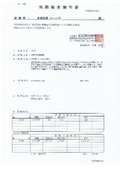光触媒『チタニスター』:純チタン不織布のチタニスター性能
アセトアルデヒドガスの分解及び反応生成物質濃度の測定
純チタン金属には不織布状の基材があります。純チタン板材を細線にしたのち 不活性雰囲気で熱融着したシート状になっています。線形は同じで厚さの違う 不織布材にチタニスター処理をし、アセトアルデヒドガスの分解及び 反応生成物質濃度の測定をしてその違いを明らかにしました。 ■使用基材 ・100mm角 不織布A 線形60μm 400g/m2 ・100mm角 不織布B 線形60μm 1200g/m2 共に気相反応系タイプのチタニスターMI-Wの処理をしてテストサンプルと しました。ちなみにAは1m2当たり400gの細線を平明状に配置し加工しています。 この厚さが3倍違う不織布チタニスターの性能テストを行いました。 ※詳しくはPDFをダウンロードしていただくか、お気軽にお問い合わせください。
基本情報
【光触媒「チタニスター」とは?】 コーティングタイプの光触媒ではありません。またこれらに使用されている原材料は一切使用していません。 純チタン金属中のチタンを表面酸化処理するだけで、純チタン表面に二酸化チタン光触媒皮膜を生成しています。 この皮膜中に不純物は含まず、純チタンに境界面なく生成しています。 高い光触媒能力、高耐久性皮膜を持つことが特徴です。 不織布Aは約50分後、Bは約60分後にガス成分は分解されました。しかし反応生成物の炭酸ガスは 無機化率相当濃度に大きな違いが認められました。Aはほぼ全量に近くまでマスバランスに近い 炭酸ガスが測定されましたが、Bは6割程度の量しか測定されませんでした。 またテスト後にAとBの不織布の臭気をかいでみたところ、Aは無臭であったがBは酢酸臭がしました。 このことから薄いAに対して厚いBの不織布はガスが内部吸着され完全分解できずにとどまっていた と推測されました。 つまり厚いため不織布内部に紫外線が照射されず光触媒反応ができなかったことがわかりました。 ※詳しくはPDFをダウンロードしていただくか、お気軽にお問い合わせください。
価格帯
納期
用途/実績例
※詳しくはPDFをダウンロードしていただくか、お気軽にお問い合わせください。






































